How to Run the Triangle Offense
I have always tried to stay away from writing about things that I wasn't sure I knew about. The Triangle Offense, for me, has always been the stock market. I have seen it, I know there are people who excel at it, it has worked well for some people, but I really don't understand it.
I recently had the great fortune to work with someone who was an expert at it. The Triangle is the only offense he runs and by being in practice with him day after day, I wanted to share what I saw before I forget it.
The Triangle is a very involved and complex offense. I don't recommend it for youth coaches. If you coach high school or higher, it would make a good system if you are in a situation where you can be sure you have a large number of returning players year after year. Tex Winter, the creator of the "Triple Post Offense" that has since become the Triangle, and Phil Jackson both agree, it takes several years to really master the offenses. So if you are in a situation where you will have the same core group of players for a few years, it might be a good system for you.
The Triangle is an offense of multiple options and the coach has to be comfortable with his players making decisions on the floor. If run correctly, the coach will certainly lose some control over what is happening on the floor. But for those who are not comfortable with ceding all decisions to the players, as he must in a motion offense, the triangle might be a good alternative. The triangle differs from a motion in that there are prescribed cuts and alignments that re-occur over and over in the execution of the offense. It is similar to a motion in that those prescribed cuts are triggered by player selected options.
This might become clearer by looking at the offense.
I am going to illustrate it by using a 1-4 set as an entry. That is not a recommendation for you. It is only because that is the way I learned it. The Lakers use a 1-3-1 set, the Bulls used a 2-3 entry. How you enter is dependent upon what you are comfortable with. Once you are in the offense, your team is always in a situation where the court is divided and there is a 3 man game on one side and a two man game on the other side.
To get FREE 33 Winning Basketball Plays, click the banner below
THE MAINFRAME
As I stated above, I will start the offense in a 1-4 set. |
|
The initial action is the ball is entered to the wing. This can be accomplished in a number of ways. The first method is a simple pass to the wing. |
|
It can also be accomplished with a dribble down |
|
Or a handoff |
|
When the ball is entered on the pass, the passer makes a corner cut. This can be accomplished with an inside cut (which could produce a give and go pass for a layup), or an outside cut. At the same time, the 5 man sinks to the strongside low post, the 2 man sinks to set up a cutting angle. |
|
The 4 man the angles to screen for 2. The 2 man cuts to the top off of the screen by 4 |
|
This resulting set is the mainframe for the triangle. This alignment can re-occur at any time. The triangle is formed but virtue of the 3 man game on the strongside and is formed, in this illustration, by the 1, 3, and 5. The Weakside, 2 man game is created with the 2 and 4 men. |
|
From this position, the ball can be passed to any player. Each pass would trigger its own, unique set of options. |
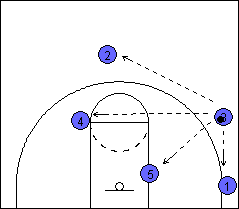
|
Once in this triangle formation, all the options become operative. When executed properly, this formation will repeat. The players have to recognize when they are aligned this way so they can react with any of the options at any time..
In addition to recognizing the alignments but they have to recognize the opportunities the options are going to present. There are back-doors, screen and rolls, turn-downs, slips, re-screens and virtually and endless supply of basketball options that players have to be allowed to explore and experiment with.
Here are some of the options. Remember, all the options are initiated with the ball on the wing in the triangle.
CORNER OPTION
3 passes to 1 in the corner |
|
|
5 steps out to backscreen for 3 3 cuts off the backscreen and there is a scoring opportunity if 1 passes to 3 on the cut. 4 rolls down to the Weakside block and prepares to be a screen for 3 should he decide to cut all the way through to the weakside. 2 flares out for spacing |
|
After 3 has cut through, 5 steps down to ball screen for 1. 4 cuts high to clear the lane and strip the help 1 and 5 play a 2 man game. They can screen and roll, screen and pop, turn-down and pop or slip. |
|
|
After exploring the 2-man game scoring options, 1 can reverse the ball by passing to 2 over the top or by going through 4 and 4 passing to 2. When the ball is reversed, 5 cuts to the strongside post. | |
|
With the ball on the wing with 2, you have recreated the strongside triange on the right side and the 2 man game on the left side. The next pass will determine the next set of cuts based on the option that the pass triggers |
|
POST OPTION
|
3 passes the ball into the post. 1 cuts along the baseline and looks for the 5-1 backdoor pass |
|
|
4 rolls down and screens for 1 to clear the help. 5 looks for a scoring opportunity 3 screens for 2 and 2 cuts to the wing |
|
|
If 5 has no scoring opportunity, he can pass out to 2 or 3 for opportunities. |
|
|
If 2 or 3 have no opportunities, they can swing the ball |
|
|
After 3 passes to 1, he corner cuts. 5 comes to the high post 2 spaces to the top |
|
|
You have now recreated the triangle alignment. The next pass will determine the next set of cuts based on the option that the pass triggers |
|
WEAKSIDE OPTION
|
The alignment has already been set with the strongside triangle and the weakside 2-man game. |
|
3 passes to 2 to initiate the Weakside option |
|
3 passes to 4 at the high post |
|
2 then goes around the 4 man and takes a handoff |
|
Another entry option After 2 receives the ball, 4 steps up to ball screen. All screen options can be used, screen and roll, screen and pop, etc. |
|
If 2 does not have a scoring opportunity, he looks to space out to the wing with the ball. |
|
If 2 is denied the reversal pass, 4 can set a back screen for 2 and explore those scoring opportunities. |
|
4 can also set a flare screen. 2 flares to the wing and those scoring options should be explored |
|
In any of those options, the ball can be reversed over the top or through the 4 man |
|
Once the ball is reversed, 2 man game options are explored. 4 ball screens for 2 5 comes up the lane for spacing |
|
4 can dive to the block 5 comes up the lane for spacing Those 2 man game scoring opportunities should be explored |
|
If there are no apparent scoring opportunities, 2 will widen the ball for spacing 3 and 1 will close into the block. Along with 5, they will prepare for multiple screening opportunities |
|
4 will roll down to the block and prepare to screen. On the weakside block, one of the perimeter players (could be either one, but in this case the 3 man) will come off a screen by the other 2 and continue to the corner, off the screen by 4.. The remaining perimeter player (in this case the 1) will come off a screen by 5. 5 will flash high. |
|
After the cuts are completed, the triangle is reset on the strong side and the 2 man game on the weak side |
|
2 can pass to any player. The next pass will determine the next set of cuts based on the option that the pass triggers |
|
If you attempt to run a handoff on the reversal option and it cannot be completed or you just decide to call it, you can run the 2nd handoff option. 2 comes off 4 and does not receive the handoff Just as if the handoff had been made, 1 and 3 close to the block. After 2 comes off 4 and it is apparent he has not taken the handoff, 2 continues his cut. He can look back door or for a spot shot, but if he doesn't get the ball, he continues to the corner. |
|
|
4 takes one or two spacing dribbles toward the Weakside. This is a trigger for the 2nd handoff. Seeing the 4 man dribble, one of the perimeter players on the block (in this case 3) comes over the top and takes the handoff from 4. The other perimeter player follows and spaces to the top. |
|
After the handoff scoring opportunities have been explored, 3 takes the ball to the wing. 4 dives to the block 5 flashes to the high post. Once again the triangle has reset itself on the ball side and the 2 man game on the weak side. The next pass will determine the next set of cuts based on the option that the pass triggers |
|
ALTERNATE ENTRIES
As with any offense, there is no perfect play and defenses prepare to defend your entries. There are some alternate entries to the triangle that are very effective and breaking pressure, providing variety and giving early scoring opportunities.
Though I am labeling the "Entries," like the rest of this offense they can be used as options whenever the alignment and situation is appropriate.
GO BEHIND ENTRY
The Go Behind entry is a great way to take advantage of a mismatch without disturbing the flow of your offense.
The entry pass goes form 1 to 2 1 then makes an outside cut. Instead of continuing to the corner, as in the regular entry, 2 hands the ball off to 1 |
|
4 sets a screen just off the elbow. 5 and 3 step up on the weakside for spacing 2 cuts over the top of the screen by 4 and then looks for space down the lane. If there are scoring opportunities to 2, they should be explored. |
|
If 2 does not have a scoring opportunity, he cuts to the corner. 4 dives to the low post |
|
The alignment is now reset with the strongside triangle and the 2 man game on the Weakside. The next pass determines which set of options can be used |
|
HIGH POST ENTRY
1 makes a direct entry pass to 4 on the high post. 2 immediately makes a hard backdoor cut and those scoring opportunities should be explored. After the 4-2 backdoor is explored, the 5 man sinks to the post |
|
1 cuts hard for a handoff 3 closes to the lane on the weakside |
|
After the handoff, 2 and 5 set a stagger screen for 3 3 cuts off the stagger screen and looks for those scoring opportunities. If he does not get the ball on the cut, he continues to the ballside corner. |
|
5 turns and screens for 2 2 cuts off the screen by 5 to the top |
|
4 dives to the strongside block. 5 rolls to the high post on the Weakside. The alignment is now reset with the strongside triangle and the 2 man game on the Weakside. The next pass determines which set of options can be used. |
|
As you can see, there are both multiple options and reoccurring situations. The motion offense similarity comes from the aspect that the players make decisions on the floor as to what options are available. The structure shows itself when an option is chosen, the cuts are pre-prescribed.
The difficulty lies in the fact that all the players have to know all the cuts and options and then react immediately to the option. Since the alignment constantly resets, the variety of options is never limited. The team may start with a corner option and then, upon reversal, when the alignment resets goes with a reversal option and then a low-post option, on infinitum.
Again, this offense may not be for everyone. The coach has to give up some control and allow his players to choose options and give them the freedom to explore what might be available within each option.
It also take time to learn so you have to have plenty of practice time and a lot of patience. Allow the offense to carry over from year to year and, with increased player experience, it will get easier for your team to play.
Related Articles & Products
How To Develop a High-Scoring Motion Offense - Instructional Guide To Building Your Motion Offense.Motion Offenses, Drills, & Tips
The High Powered Dribble Drive Motion Offense
To get FREE 33 Winning Basketball Plays, click the banner below
Leave your comments, suggestions, and questions below...
|
||||||||||||||||||||||||||


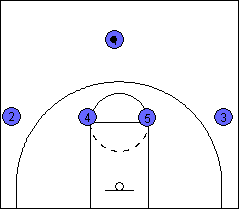
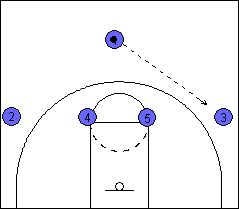
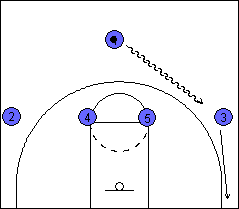
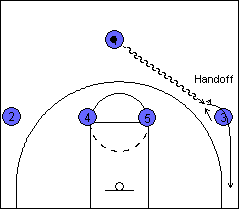
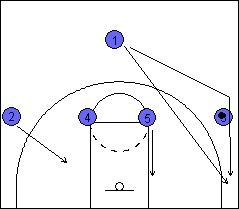
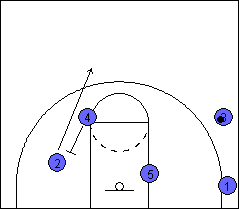
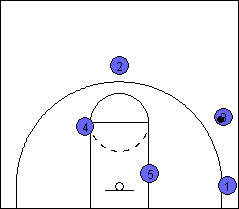
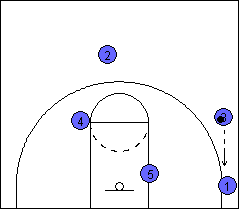
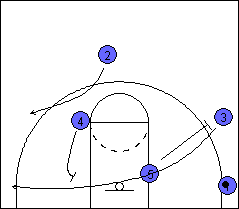
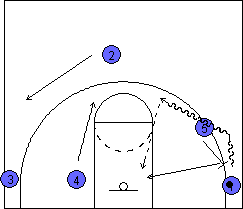
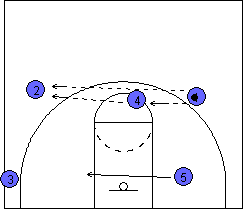
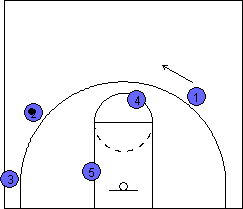
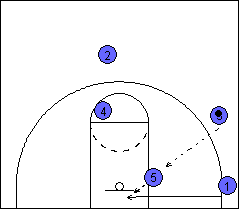

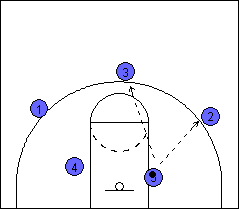
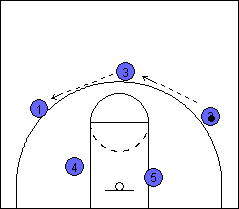

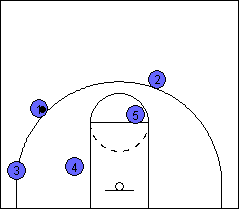
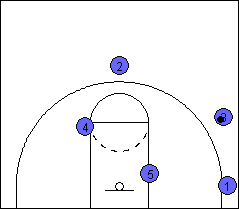
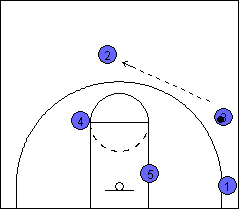
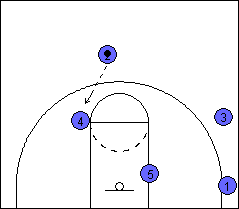
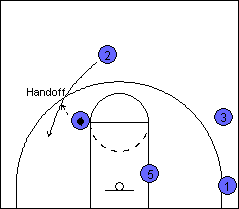
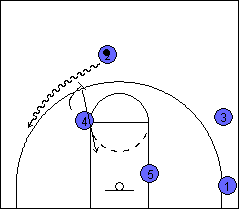
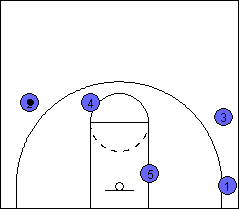
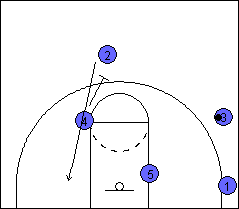
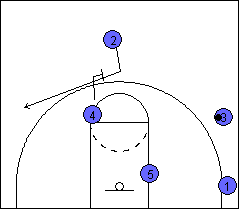
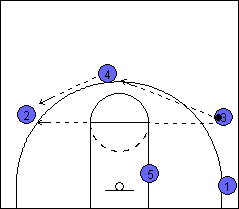
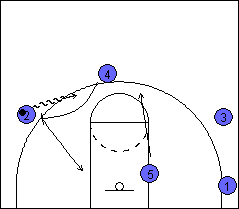
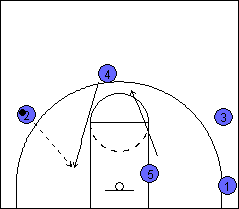
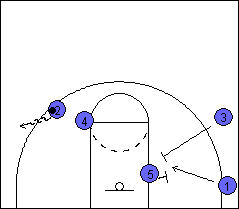
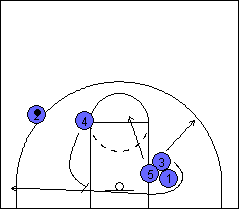
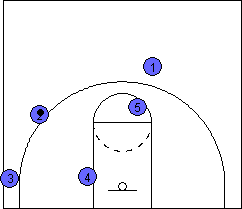
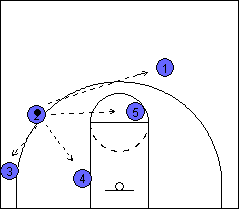
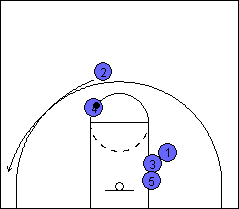
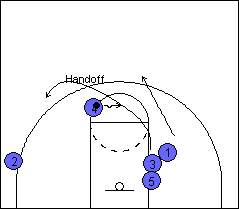
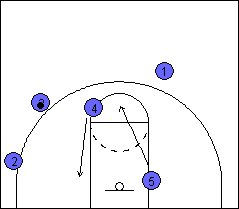
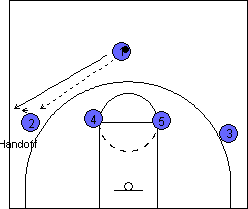
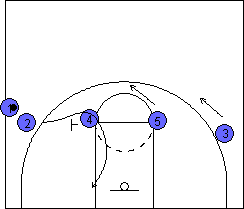
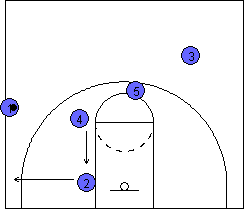
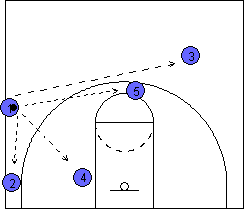
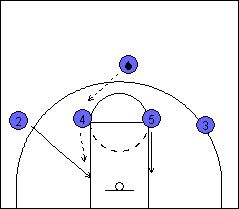
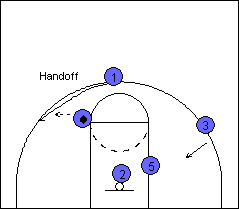
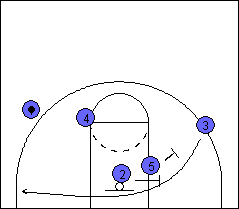
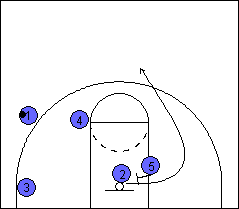
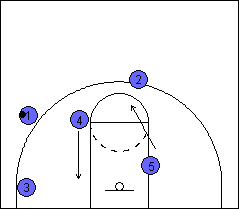


 Facebook (145k Followers)
Facebook (145k Followers) YouTube (152k Subscribers)
YouTube (152k Subscribers) Twitter (33k Followers)
Twitter (33k Followers) Q&A Forum
Q&A Forum Podcasts
Podcasts